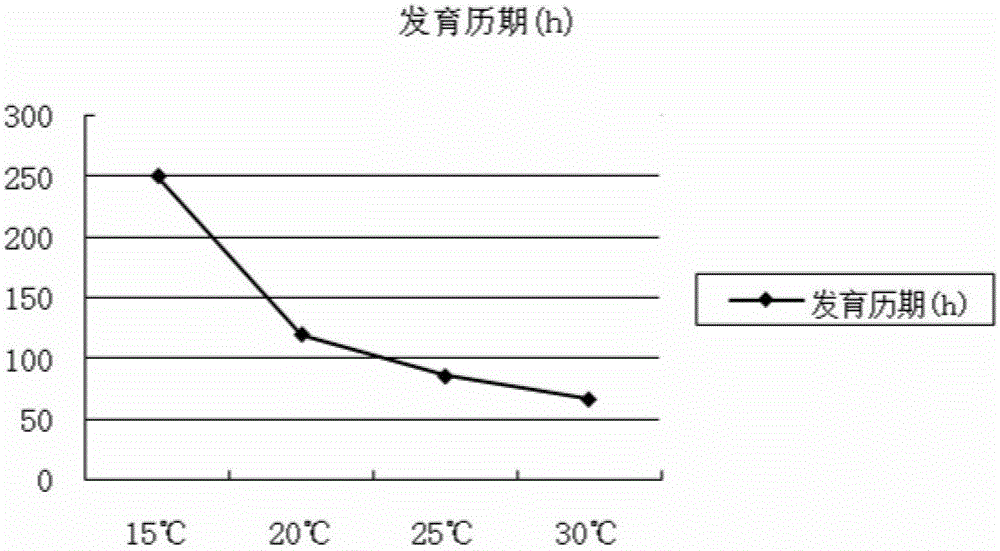Method for propagating chrysopa pallens larvae through rice moth eggs
A technology of lacewing and rice moth eggs, applied in the application, animal feed, animal feed and other directions, can solve the problem of insignificant effect, and achieve the effects of high labor cost, large space occupation, and convenient factory production.
- Summary
- Abstract
- Description
- Claims
- Application Information
AI Technical Summary
Benefits of technology
Problems solved by technology
Method used
Image
Examples
Embodiment 1
[0034] The influence of embodiment 1 three kinds of feeds on the growth and development of the large lacewing
[0035] 1 Materials and methods
[0036] The artificial eggs of Trichogramma pupae, rice moth eggs and aphids were used as food, and the newly hatched lacewing larvae were reared in a glass feeding tube (500ml) with paper strips as spacers. Add enough feed every day to pupate cocoons in time every day after pupation. 5 cylinders were raised for each treatment. Observe and record the larval duration, pupal duration, pupation rate and eclosion rate every day. After 3 days of cocooning, the pupae were weighed electronically. Observe and record the survival of each insect state.
[0037] During the experiment, the temperature was 27±1℃, the photoperiod was L:D=14:10, and the relative humidity was 70±5%.
[0038] 2 Results and Analysis
[0039] 2.1 Effects of different feed treatments on the growth and development of the lacewing
[0040] It can be seen from Table 1...
Embodiment 2
[0052] The hatching of embodiment 2 big lacewing ovum and cold storage condition
[0053] 1 Materials and methods
[0054] 1.1 The influence of temperature and humidity
[0055] The treatment temperature gradient was set at 15°C, 20°C, 25°C, and 30°C, and the humidity was set at 35% and 70%. Collect fresh eggs produced by the lacewing within 12 hours, pack 20 eggs in each finger tube, and use 5 tubes for each temperature gradient. Repeat 3 times. Observe the development of the eggs every day, and observe every 2 hours when the surface of the eggs turns black and hatches quickly. Record the developmental period and hatching status of eggs in each treatment.
[0056] 1.2 Cold storage of Lacewing eggs
[0057] Eggs developed at 27°C to different stages were collected: within 8 hours after birth, 24-32 hours after birth, and 48-56 hours after birth, and packed into finger tubes, 80 eggs per tube. According to the starting point temperature of egg development, 4 temperature g...
Embodiment 3
[0080] Embodiment 3 stocking density and the influence of temperature on cannibalism
[0081] 1 Materials and methods
[0082] 1.1 Stocking density
[0083] Raise the 1st instar larvae of lacewings in a 15×10 (diameter*height) round box, with a density of 30, 60, 90, 120, and 150 per box, isolate them with a 5mm wide paper strip, repeat 3 times, and feed enough of aphids. Observe and record the pupation (cocooning) rate of each treatment. And with a single independent feeding as a control. During the test, the temperature was 27°C, the photoperiod was L:D=14:10, and the relative humidity was 70±5%.
[0084] 1.2 Breeding temperature
[0085] At 20°C, 25°C, and 30°C, 50 newly hatched larvae were reared in each box. 3 repetitions. 50 larvae were raised in each cylinder, and the pupation (cocooning) rate of each treatment was observed and recorded. And with a single independent feeding as a control. During the test, the photoperiod was L:D=14:10, and the relative humidity...
PUM
| Property | Measurement | Unit |
|---|---|---|
| Diameter | aaaaa | aaaaa |
Abstract
Description
Claims
Application Information
 Login to View More
Login to View More - R&D
- Intellectual Property
- Life Sciences
- Materials
- Tech Scout
- Unparalleled Data Quality
- Higher Quality Content
- 60% Fewer Hallucinations
Browse by: Latest US Patents, China's latest patents, Technical Efficacy Thesaurus, Application Domain, Technology Topic, Popular Technical Reports.
© 2025 PatSnap. All rights reserved.Legal|Privacy policy|Modern Slavery Act Transparency Statement|Sitemap|About US| Contact US: help@patsnap.com



